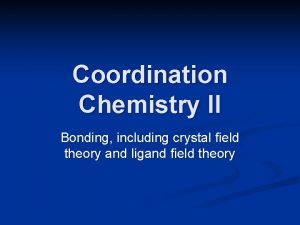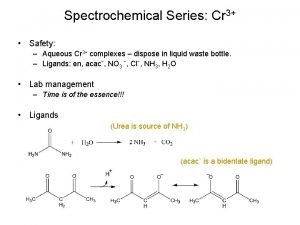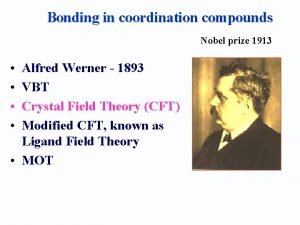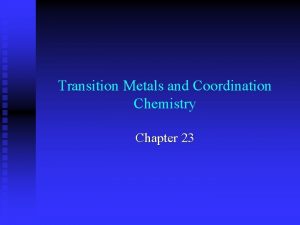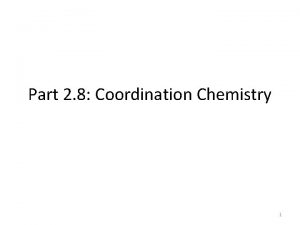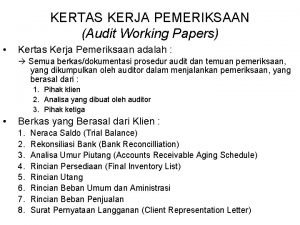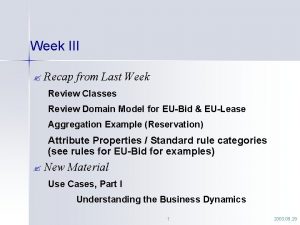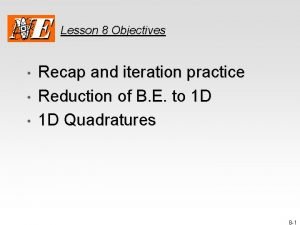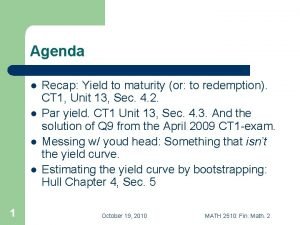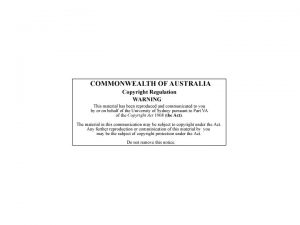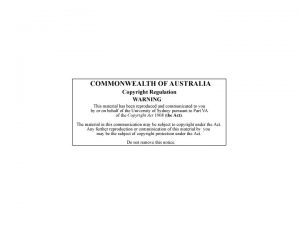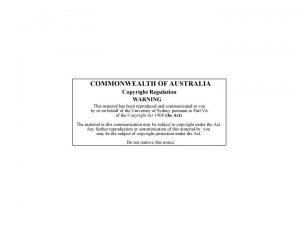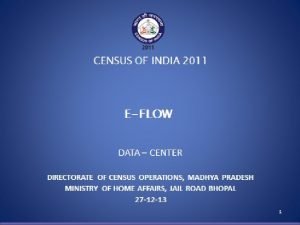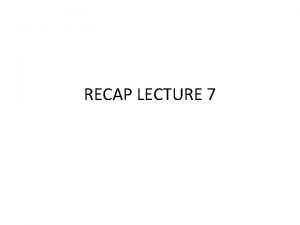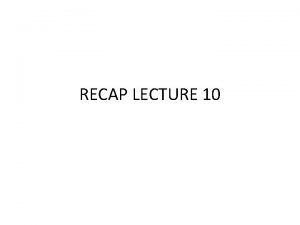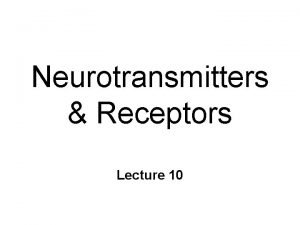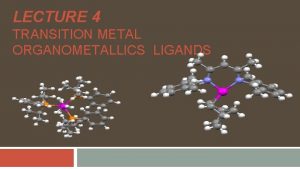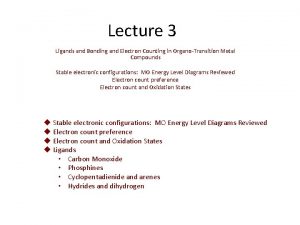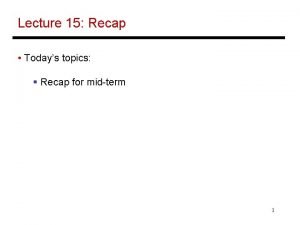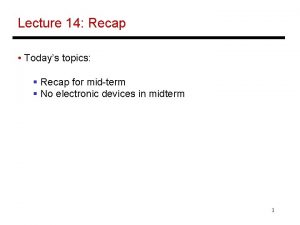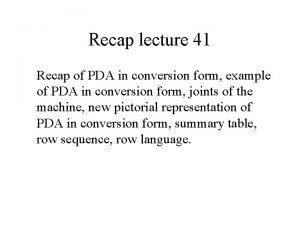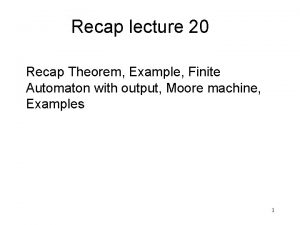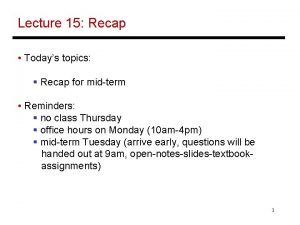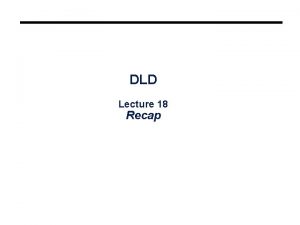Schedule Lecture 4 Recap Lecture 5 pAcceptor Ligands


















- Slides: 18


Schedule • Lecture 4: Re-cap • Lecture 5: p-Acceptor Ligands and Biology CO and O 2 complexes • Lecture 6: N 2 and NO complexes, M-M bonds More on p-acceptor ligands, introduction to metal-metal bonding Slide 2/18

Summary of the Last Lecture Metal-carbonyl complexes • Bonding is due to synergic OC M s-donation and M CO p-back donation • Reduction in vco stretching frequency is related to the extent of back-bonding • Number of v. CO in IR and Raman can be used to work out structure O 2 complexes • Haemoglobin and myoglobin bind weakly to O 2 allowing transport and storage of highly reactive molecule Today’s lecture • N 2 complexes and Metal-Metal bonding Slide 3/18

Molecular Orbitals for N 2 and CO 2 psu 2 ppg 2 psg 2 p 2 p 2 ppu 2 ps 2 p 2 p 2 pp 2 s 2 s N N 2 2 s 2 s N O CO C Slide 4/18

Molecular Orbitals for N 2 and CO • CO: Ø bond order = 3 (C≡O triple bond) Ø HOMO is dominated by C 2 pz (~ C “lone pair”) Ø LUMOs are dominated by C 2 px and 2 py: • N 2 : Ø bond order = 3 (N≡N triple bond) Ø HOMO delocalized over both N (not a “lone pair”) Ø LUMOs are also shared equally: Slide 5/18

Metal-N 2 Complexes • N 2 bonds to transition metals in a similar way to CO (see Lecture 5 Slide 5) Ø σ-donation from N≡N: M Ø p-back donation from M: N≡N: (reduces N≡N bond strength) Ø synergic Ø weaker than for M-CO free N 2: v. N≡N = 2331 cm-1 1900– 2200 cm-1 ~2100 cm-1 Slide 6/18

Fixing Nitrogen • Nature needs to obtain nitrogen from atmospheric N 2 Ø nitrogen content of soil is often the growth limiting factor Ø around 17 million tonnes of NH 3 per year industrially Ø natural fixation about 2. 5 times more important • To use atmospheric N 2, nature uses metal-enzymes: Ø nitrogen fixation (nitrogenase) converts N 2 to NH 4+ Ø nitrification converts NH 4+ to NO 3 - which can be taken up by plants • Nitrogenase faces a number of problems: Ø thermodynamic stability of N≡N bond means reaction is unfavourable Ø N 2 is non-polar and unreactive: efficient enzymes/catalysts are required Ø M-N 2 bonds are weak Slide 7/18

Nitrogenase – Fe protein • Nitrogenase contains Fe and Mo and is made up of two proteins Ø ‘Fe protein’ contains a pseudo-cubic [4 Fe-4 S] cluster: Ø Cluster contains 2 × Fe 2+ and 2 × Fe 3+ Ø Tetrahedral coordinate about Fe from 2 × S 2 - and 2 × S from cysteine role: oxidation of Fe 2+ to Fe 3+ provides electrons (energy for oxidation comes from hydrolysis of 2 ATP molecules per electron) Slide 8/18

Nitrogenase – Fe. Mo protein • Nitrogenase contains Fe and Mo and is made up of two proteins Ø ‘Fe. Mo protein’ contains two [8 M-8 S] clusters 1. [8 Fe-8 S] role: transfer of electrons from Fe protein Slide 9/18

Nitrogenase – Fe. Mo protein • Nitrogenase contains Fe and Mo and is made up of two proteins Ø ‘Fe. Mo protein’ contains two [8 M-8 S] clusters 2. [Mo 7 Fe-8 S] role: attachment and reduction of N 2 Slide 10/18

Nitrogenase – Fe. Mo protein • Site and mode of attachment of N 2 to [Mo 7 Fe-8 S] cluster is not known Ø probably Fe rather than Mo Ø possibly between two central Fe atoms: role of Mo: asymmetry in cluster probably induces a small polarity in N 2 bond, facilitating electrophilic attack Slide 11/18

Nitrogenase – Reduction of N 2 • Multiple stepwise addition of e- and H+ Ø e- from Fe protein Ø energy from ATP hydrolysis: LM-N≡N e- and H+ LM=N=NH e- and H+ LM≡N-NH 2 e- and H+ N 2 LM NH 3+ LM≡N-NH 3+ H+ LM-NH 3 2 e- and 2 H+ LM=NH e- and H+ LM≡N NH 3+ Slide 12/18

Molecular Orbitals for N 2 and NO 2 psu 2 ppg 2 psg 2 p 2 p 2 ppu 2 ps 2 p 2 p 2 pp 2 s 2 s N N 2 2 s 2 s N O NO N bond order = ½ (8 – 3) = 2. 5

Bonding in M-NO Complexes • NO - two ways of bonding: Ø as NO+ - isoelectronic with CO Ø 2 e- s-donation from O=N: M Ø p-back donation from M: NO Ø as NO- - isoelectronic with O 2 Ø 1 e- s-donation from O=N: M Slide 14/18

NO Synthase and Nitrophorin • • • NO is used as a signalling molecule in mammals NO synthase is a haem protein which produces NO upon receipt of a signal Nitrophorin is found in some bloodsucking parasites (“kissing bugs”) • it is a haem protein that binds NO tightly p. H = 5 (in saliva of bug) • it releases NO at p. H = 7. 4 (in blood of victim) • NO release signals to dilate blood vessels, aiding ‘blood donation’ Slide 15/18

Maximum Bond Orders – s and p-Block 2 psu 2 ppg 1 s 1 s 2 psg 2 p 2 p 2 ppu H H 2 H • maximum bond order for sblock is 1 2 s • maximum bond order for pblock is 3 N 2 s N 2 N Slide 16/18

Maximum Bond Order – d-Block 3 dsu • the maximum bond order is 5 3 dpg • but…complexes also contain ligands which use some of the dorbitals reducing number of bonds 3 ddu 3 d 3 d 2× dx 2 -y 2 + dx 2 -y 2 dxy + dxy 2× dxz + dxz dyz + dyz 3 ddg 3 dpu 3 dsg dz 2 + d z 2 Slide 17/18

Summary By now you should be able to. . • Explain that why M-N 2 bonding is much weaker than MCO bonding • Count electrons in NO complexes containing bent M-NO (1 e- donor) or conraining linear M-NO (2 e- donor Next lecture • Metal-Metal bonding in complexes Slide 18/18
 Beer lambert law in uv spectroscopy
Beer lambert law in uv spectroscopy Biological importance of transition metals
Biological importance of transition metals Triamminetriaquachromium(iii)
Triamminetriaquachromium(iii) Inert and labile complexes
Inert and labile complexes![Complexes of the type [m(aa)3]tn Complexes of the type [m(aa)3]tn](data:image/svg+xml,%3Csvg%20xmlns=%22http://www.w3.org/2000/svg%22%20viewBox=%220%200%20200%20200%22%3E%3C/svg%3E) Complexes of the type [m(aa)3]tn
Complexes of the type [m(aa)3]tn Pi donor ligands
Pi donor ligands Spectrochemical series trick
Spectrochemical series trick Spectrochemical series
Spectrochemical series Cfse of co(h2o)6 3+
Cfse of co(h2o)6 3+ Ammonium diamminetetrachlorocobaltate(ii)
Ammonium diamminetetrachlorocobaltate(ii) Point charge
Point charge Kertas kerja prosedur pemeriksaan
Kertas kerja prosedur pemeriksaan Bmfp
Bmfp Recap from last week
Recap from last week What is the purpose of an iteration recap
What is the purpose of an iteration recap Descriptive ethics vs normative ethics
Descriptive ethics vs normative ethics Scene
Scene Ytm recap
Ytm recap Recap
Recap
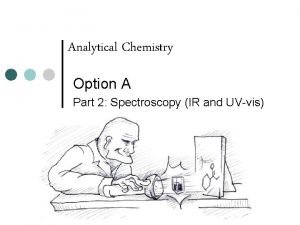
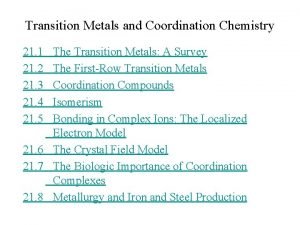
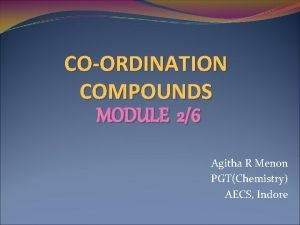
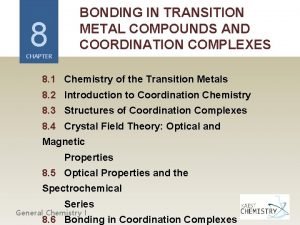
![Complexes of the type [m(aa)3]tn Complexes of the type [m(aa)3]tn](https://slidetodoc.com/wp-content/uploads/2020/12/3015715_d8412bc28f0c7b6a8c2ea3744ce60d97-300x225.jpg)
